Miniature Painting in Eighteenth-Century England: The Case of William Pether (1739–1821)
Abstract
:1. Introduction
- It is more delicate.
- It requires a nearer View.
- It is not easily done but in Little.
- It is wrought only upon Velum or Paper.
- And the Colours are diluted only with Gum-water.
2. Miniature Painting in England
The eighteenth-century miniature has completely new influences. First of all, after the theatrical manner of Piotr Lely and Gotffried Kneller, who influenced the last painters of the miniatures of the era (Flatman, Dixon) unfavorably, a new revelation in the art of portraying was introduced by Gainsborough, Romney, Lawrence, and especially Reynolds, who had a decisive influence on Cosway, Engleheart, and Ozias Humphrey.
3. William Pether—Mezzotint Engraver and Miniature Painter
4. A New Light on the Attribution of the Artist’s Miniatures
I have seen a miniature of an officer in a red coat signed W. P. in sloping Roman capitals, (c. 1793). The background was painted with long blue strokes, some curved, running in various directions, the hair was painted with long blue strokes and a few stippled lines; the face was shaded with blue, delicate hatchings, but there was a little red at the eyelids and corner of the eyes and at the cheek, mouth, and base of the nose.
5. Conclusions
Funding
Institutional Review Board Statement
Informed Consent Statement
Data Availability Statement
Acknowledgments
Conflicts of Interest
| 1 | He is also author of the treatise “Of Limning”, a manuscript at the University of Edinburgh. Typical of these miniatures is that they show the bust of the portrayed person en face as well as en trois quart. The portrayed persons fill the entire composition, as in the modern “law of the frame”. There are no free spaces here, and a uniform background occupies a small part of the entire metal surface, on which, sometimes, inscriptions are included. Portraits of men dominate and are characterized by lack of shading, little visual depth, matte complexions, and richly ornamented costumes. In Paris circa 1700, miniatures were created by the Flemish miniaturist van Blarenberghe and later Klingstedt, also referred to as “Raphael des tabatières”. |
| 2 | As a base for miniatures, sheep or calf parchment (vellum) or pecorella (stillborn lambs’ skin) was used. Over time, the use of cardboard, the reverse side of playing cards, paper, silk, tree, metal sheets (zinc, copper, silver, gold), enamel, corner, tortoise shell, porcelain, glass, and ram’s bones began to be popular. Ivory was the last base adopted, ultimately supplanted in the second half of the nineteenth century by the invention of the Daguerreotype. In addition to these major types of base, there were also miniature paintings on lace, wax, and stearin plaster. |
| 3 | In addition to this method, another technique, table bookleaf, created a plate by covering parchment with a layer of gesso on both sides. This allowed the parchment surface to be stiffened and smoothed. In addition, it was also possible to increase the size of the miniature. Each artist had their own way of developing pigments, but the most common was gouache and watercolor. Pigments were combined with a binder, usually acacia gum or gum Arabic. |
| 4 | She began painting miniatures for the lids of snuff boxes and was the first painter to use ivory instead of vellum for this purpose. Thanks to this material, which initially had a thickness of 1–2 mm and was later decreased to 0.1–0.2 mm, the paint layer could be thinner, lighter, and more delicate. |
| 5 | One of the first British artists to start using ivory as a foundation for miniatures was Bernard Lens (1682–1740). However, the main breakthrough in miniature painting was made by Richard Cosway (1742–1821), who introduced a new way of using watercolors on ivory so that they looked natural—like watercolor on paper. Over time, parchment fell out of use, and the widely available paper began supplanting the much more expensive ivory. |
| 6 | Pether, despite being an engraver, publisher, and miniaturist, invented an “Apparatus to promote the escape of smoke” (from the chimney). This 1804 invention got a patent and was fully described in 1804 (Pether 1804). |
| 7 | Miniatures representing Queen Charlotte and King George III were also painted by Jeremiah Meyer: an oval miniature on a bracelet with a representation of George III from 1761, and a watercolor on ivory entitled Queen Charlotte and dated 1770. In 1789, William Pether engraved Portrait of Jeremiah Meyer, now in the British Museum, London (1902; 1011.3639). |
| 8 | It is difficult to recapture information published on the Cynthia Walmsley website (www.c-walmsley.co.uk), since it ceased to exist two years ago. The information quoted came from private research conducted several years ago. It is not possible, at present, to corroborate the source of these details. |
| 9 | William Pether, Mr William Pether Engraver, mezzotint, 366 × 274 mm, British Museum, London (1852; 0214.312). |
| 10 | “Don Mailliw Rehtep/pinxit et Fecit/Will. Pether Engraver”. |
| 11 | William Pether, Self-portrait, c. 1770–1780, mezzotint, Art Gallery of Ontario (AGOID.106997). This miniature was offered for auction at Galerie Fischer in Lucerne (lot 843) and then sold by Christie’s, London (lot 176), on 27 November 2007 (Christie’s 2007); (Fischer 1960). It was estimated at GBP 6000–8000 and the final price was GBP 10,000. |
| 12 | The portrait was sold at the Halls Fine Art auction of Miniatures & Works of Art at Shrewsbury on 13 November 1996 (lot 352) and is now part of a private collection (Halls Fine Art Auctioneers Shrewsbury 1996). |
| 13 | Elisabeth-Louise Vigée-Lebrun, Portrait of Madame, Comtesse de Provence, 1777, drawing, Royal Collection Trust, London (RCIN 913123). |
| 14 | It is important that not all of William Pether’s engravings have signatures (pinxit, fecit) but this one has the signature “W. Pether.” This signature, verified, appears on the other mezzotints. |
| 15 | William Pether, Madame, 1778, mezzotint, British Museum, London (1902; 1011.3645). |
| 16 | William Pether, Madame, 1778, mezzotint, Royal Collection Trust, London (RCIN 617550). |
| 17 | The provenance and history of the miniature is unknown; it is also said to have come from a private collection and was sold by Stam Gallery Appraisers, Washington, NY, in early 2016 and then by Shannon’s Fine Art Auctioneers in Milford, CT, on 27 October 2016 (lot 98), with an estimated value of USD5000–7000. It is now part of a private collection (Shannon’s Fine Art Auctioneers 2016). |
| 18 | Portrait of a Man belongs to the Metropolitan Museum of Art in New York and was donated in 1968 by Lilliana Teruzzi (MET 1996). |
| 19 | A stock tie is a form of neck-cloth that was often stiffened and usually close-fitting, formerly worn by men but also used in military uniforms. |
| 20 | “An Officer, Wearing Red Coatee, With Blue Facings, Cuffs and Standing Collar”. Mutual Art. Available online: https://www.mutualart.com/Artwork/An-Officer--wearing-red-coatee--with-blu/1DF54E2ECFB0C028 (accessed 12 October 2019). |
| 21 | John Hoppner, An Unknown British Officer, c. 1800, oil painting, Yale Center for British Art (B1977.3), New Haven, CT. |
| 22 | Preceding and later titles: 1685—The Duke of Beaufort’s ‘Musketeers’, 1751—The 11th Regiment of Foot, 1881—The Devonshire Regiment. |
| 23 | The miniature was sold at Sotheby’s on 26 June 1978 (lot 188), and then again at Christie’s on 14 October 1988. It is now (since 2009) part of the Comeford Collection at the Irish Architectural Archives in Dublin (Sotheby’s 1978). |
| 24 | Nathaniel Dance, Self-portrait, 1773, National Portrait Gallery, London (NPG 3626). |
| 25 | Angelica Kauffmann, Nathaniel Dance, 1764, Victoria and Albert Museum in London (E.384-1927). The Royal Collection Trust indicates the date of the drawing as 1764, whereas the V&A dates it around 1790. |
| 26 | Half-length portrait of a man, wearing a black coat and vest with embroidered silk lapels. The miniature was sold by Millon & Associés in Paris on 17 June 2016 (lot 189), with the title Portrait d’homme en buste portant un habit noir et gilet avec revers en soie brodé (Millon 2016). |
| 27 | William Pether, A Farrier’s Shop, 1771, mezzotint, British Museum, London (1870; 0514.485). |
| 28 | William Pether, An Academy, 1772, mezzotint, British Museum, London (2010; 7081.2228). |
| 29 | Pether was a scholar of Thomas Frye, who taught him porcelain painting (Cora 2021, p. 290). |
References
- Alexander, David, ed. 2021. Pether, William (c.1738–1821). In A Biographical Dictionary of British and Irish Engravers 1714–1820. New Haven and London: Paul Mellon Centre for Studies in British Art, Yale University Press. [Google Scholar]
- Shannon’s Fine Art Auctioneers, ed. 2016. Fine American and European Paintings, Drawings, Prints and Sculpture. 27 October 2016. Milford: Shannon’s Fine Art Auctioneers. [Google Scholar]
- Bénézit, Emmanuel, ed. 1948. William Pether. Dictionnaire Critique et Documentaire des Peintres, Sculpteurs, Dessinateurs et Graveurs. Paris: Librairie Grund. [Google Scholar]
- Boutet, Claude. 1739. The Art of Painting in Miniature. London: J. Hodges. [Google Scholar]
- Christie’s, ed. 2007. Live Auction 7453 Important Portrait Miniatures and Gold Boxes Lot 176 ‘William Pether (British, 1738–1821). London: Christie’s. [Google Scholar]
- Cora, Dominika. 2021. New Light on the Life and Work of the Mezzotint Engraver William Pether (1739–1821). Print Quarterly XXXVIII: 289–301. [Google Scholar]
- Davenport, Cyril. 1908. Miniatures: Ancient and Modern. Chicago: A. C. McClurg and Co. [Google Scholar]
- Davenport, Cyril. 1913a. The Art of Miniature Painting. Lecture III. Journal of the Royal Society of Arts 61: 839–44. [Google Scholar]
- Davenport, Cyril. 1913b. The Art of Miniature Painting. Lecture II. Journal of the Royal Society of Arts 61: 825–30. [Google Scholar]
- Davenport, Cyril. 1913c. The Art of Miniature Painting. Lecture I. Journal of the Royal Society of Arts 61: 811–17. [Google Scholar]
- Day, Charles William. 1852. The Art of Miniature Painting. London: Winsor and Newton. [Google Scholar]
- Dudley, Heath. 1905. Miniatures. New York: G. P. Putnam’s Sons. [Google Scholar]
- Fischer, Galerie. 1960. Bedeutende Kunstauktion in Luzern. Mobiliar Aus Schweizer Privatsammlungen Luzerner Zinnsammlung Gemälde Aus Kollektion Hand, R. Und de M. Auktion in Luzern Am 21, 22, 23, 24, 25. und 27. Juni 1960. Luzern: Galerie Fischer. [Google Scholar]
- Foskett, Daphne. 1972. A Dictionary of British Miniature Painters. New York: Praeger Publishers, vol. II. [Google Scholar]
- Foskett, Daphne. 1979. Collecting Miniatures. London: Antique Collector’s Club. [Google Scholar]
- Gordon, John, ed. 2001. Evil Eye. Encyclopedia of Occultism and Parapsychology. Detroit, New York, San Francisco, London: Gale Group, vol. 1. [Google Scholar]
- Goulding, Richard W. 1914–1915. The Welbeck Abbey Miniatures. The Walpole Society 4: 1–224. Available online: https://www.jstor.org/stable/i40086498 (accessed on 12 April 2020).
- Graham, Reynolds. 1962. English Portrait Miniatures. London: Adam & Charles Black. [Google Scholar]
- Graves, Algernon. 1906. The Royal Academy of Arts. A Complete Dictionary of Contributors and Their Work from Its Foundation in 1769 to 1904. London: H. Graves and Co., London: George Bell and Sons, vol. VI. [Google Scholar]
- Graves, Algernon. 1907. The Society of Artists of Great Britain 1760–1791. The Free Society of Artists 1761–1783. A Complete Dictionary of Contributors and Their Work from the Foundation of the Societies to 1791. London: George Bell and Sons. [Google Scholar]
- Haywood, Emma. 1890. Miniature Painting. The Art Amateur 23: 69–70. [Google Scholar]
- Holck, Colding Torben. 1953. Aspects of Miniature Painting: Its Origins and Development. Copenhagen: E. Munksgaard. [Google Scholar]
- Humphreys, M. A. P. 1872. En Miniature. From the German of Elize Polko. The Aldine 5: 132–33. [Google Scholar] [CrossRef]
- Jeffaers, Neil. 2021. Dictionary of Pastellists Before 1800. Available online: http://www.pastellists.com/Articles/PETHER.pdf (accessed on 12 April 2020).
- Kendrick, Emma Eleonora. 1830. Conversations on the Art of Miniature Painting. London: Privately Printed for the Author. [Google Scholar]
- Long, Basil S. 1929. British Miniaturists. London: Geoffrey Bles. [Google Scholar]
- Mansion, Andre Leon Laure. 1822. Letters Upon the Art of Miniature Painting. London: A. Ackerman. [Google Scholar]
- McClenehan, Helen J. 1930. Miniature Eye Portrait. Bulletin of the Pennsylvania Museum 26: 28–31. [Google Scholar]
- MET. 1996. European Miniatures in the Metropolitan Museum of Art. New York: The Metropolitan Museum of Art. [Google Scholar]
- Millon. 2016. Collections & Successions—Mobilier & Objets d’Art Prestige. 17 June 2016. Paris: Millon. [Google Scholar]
- O’Donoghue, Freeman Marius. 1909. Pether William. Edited by Leslie Stephen and Sidney Lee. Dictionary of National Biography. London: The Macmillan Company, vol. XV. [Google Scholar]
- Parsey, Arthur. 1831. The Art of Miniature Painting on Ivory. London: Printed for Longman, Rees, Orme, Brown, and Green. [Google Scholar]
- Pether, William. 1757. Flower Design. London: Royal Society of Arts, Manufactures and Commerce Archives. [Google Scholar]
- Pether, William. 1758. Decorative Design in Colour. Manufactures and Commerce Archives. London: Royal Society of Arts. [Google Scholar]
- Pether, William. 1770. A Letter of William Pether, G. Russel Street, Bloomsbury, to James Paine, Declining His Election as a Member of the Committee for Conducting the Academy in Maiden Lane, Read at a Meeting of the Directors. July 11. London: Royal Academy Archives. [Google Scholar]
- Pether, William. 1776. Marriage Certificate of William Pether of the Parish of St. James Westminster in the County of Middlesex and Elizabeth Cook of the Parish of Nottingham, Nottinghamshire. March 20. Nottingham: Nottinghamshire Archives. [Google Scholar]
- Pether, William. 1801. Letter from William Pether about Refining Whale Oil. April 2. Bristol: Royal Society of Arts, Manufactures and Commerce Archives. [Google Scholar]
- Pether, William. 1802. Letter from William Pether about Refining Whale Oil. March 22. Bristol: Royal Society of Arts, Manufactures and Commerce Archives. [Google Scholar]
- Pether, William. 1804. Specification of William Pether. Apparatus to Promote the Escape of Smoke. 1804, No. 2778. London: G. E. Eyre & W. Spottiswoode. [Google Scholar]
- Pointon, Marcia. 2001. Surrounded with Brilliants: Miniature Portraits in Eighteenth-Century England. The Art Bulletin 83: 48–71. [Google Scholar] [CrossRef]
- Przesmycki, Zygmunt. 1912. Pamiętnik Wystawy Miniatur oraz Tkanin i Haftów, Urządzonej w Domu Własnym w Warszawie przez Towarzystwo Opieki nad Zabytkami z Przeszłości w Czerwcu i Lipcu 1912 Roku. Warszawa: Towarzystwo Opieki nad Zabytkami. [Google Scholar]
- RISA. 1769. A Catalogue of the Pictures, Sculptures, Designs in Architecture, Models, Drawings, Prints, etc. Exhibited at the Great Room Spring-Garden, Charing-Cross, 1 May 1769. London: Printed by William Bunce. [Google Scholar]
- RISA. 1770. A Catalogue of the Pictures, Sculptures, Designs in Architecture, Models, Drawings, Prints, etc. Exhibited at the Great Room Spring-Garden, Charing-Cross, 16 April 1770. London: Printed by William Bunce. [Google Scholar]
- RISA. 1771. A Catalogue of the Pictures, Sculptures, Designs in Architecture, Models, Drawings, Prints, etc. Exhibited at the Great Room Spring-Garden, Charing-Cross, 26 April 1771. London: Printed by William Bunce. [Google Scholar]
- RISA. 1777. A Catalogue of the Pictures, Sculptures, Designs in Architecture, Models, Drawings, Prints, etc. Exhibited at the Great Room Spring-Garden, Charing-Cross, 28 April 1777. London: Printed by T. Bensley. [Google Scholar]
- SAGB. 1764. A Catalogue of the Pictures, Sculptures, Models, Drawings, Prints, etc. Exhibited by the Society of Artists of Great Britain, at the Great Room in Spring-Garden, Charing-Cross, 9 April 1764. London: Printed by William Bunce. [Google Scholar]
- SAGB. 1765. A Catalogue of the Pictures, Sculptures, Models, Designs in Architecture, Prints, etc. Exhibited by the Society of Artists of Great Britain, Instituted by His Majesty’s Royal Charter, 26 January 1765. London: Printed by William Bunce. [Google Scholar]
- SAGB. 1766. A Catalogue of the Pictures, Sculptures, Models, Drawings, Prints, etc. Exhibited by the Society of Artists of Great Britain at the Great Room in Spring-Garden, Charing-Cross, 21 April 1766. London: Printed by William Bunce. [Google Scholar]
- SAGB. 1768. A Catalogue of the Pictures, Sculptures, Models, Drawings, Prints, etc. Exhibited by the Society of Artists of Great Britain at the Great Room in Spring-Garden, 28 April 1768. London: Printed by William Bunce. [Google Scholar]
- Halls Fine Art Auctioneers Shrewsbury. 1996. Miniatures & Works of Art. 13 November 1996. Shrewsbury: Halls Fine Art Auctioneers Shrewsbury. [Google Scholar]
- Sotheby’s. 1978. Fine Art and Miniatures. 26 June 1978. London: Sotheby’s. [Google Scholar]
- Whittock, Nathaniel. 1844. The Miniature Painter’s Manual: Containing Progressive Lessons on the Art of Drawing and Painting Likenesses from Life on Card-Board, Vellum, and Ivory. London: Sherwood. [Google Scholar]
- Wickes, Henry Leonard. 1974. Regiments of Foot. A Historical Record of All the Foot Regiments of the British Army. Oxford: Osprey Publishing. [Google Scholar]
- Williamson, George Charles. 1904. How to Identify Portrait Miniatures. London: G. Bell and Sons. [Google Scholar]
- Williamson, George Charles. 1921. The Miniature Collector. A Guide for the Amateur Collector of Portrait Miniatures. London: H. Jenkins Limited. [Google Scholar]
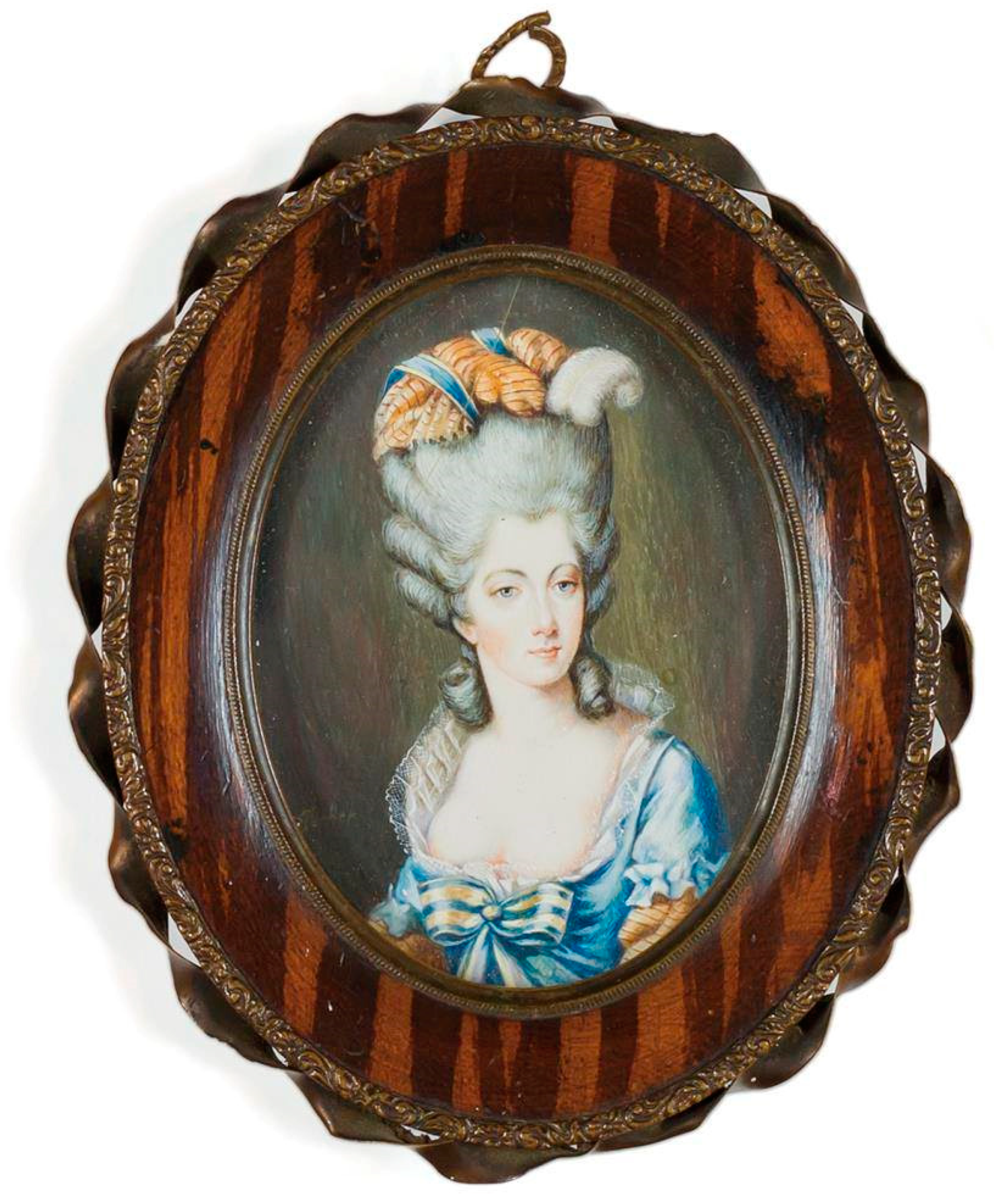
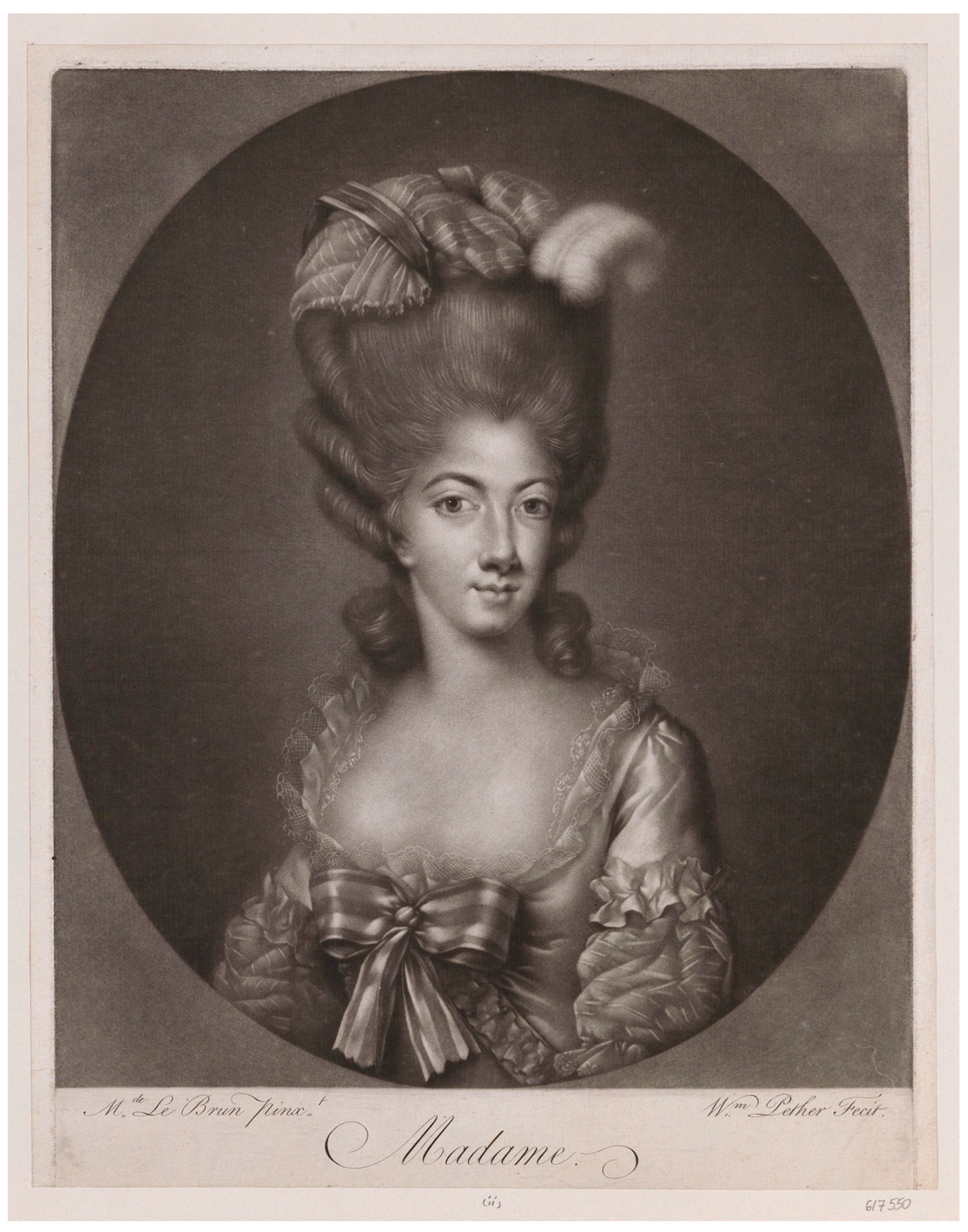
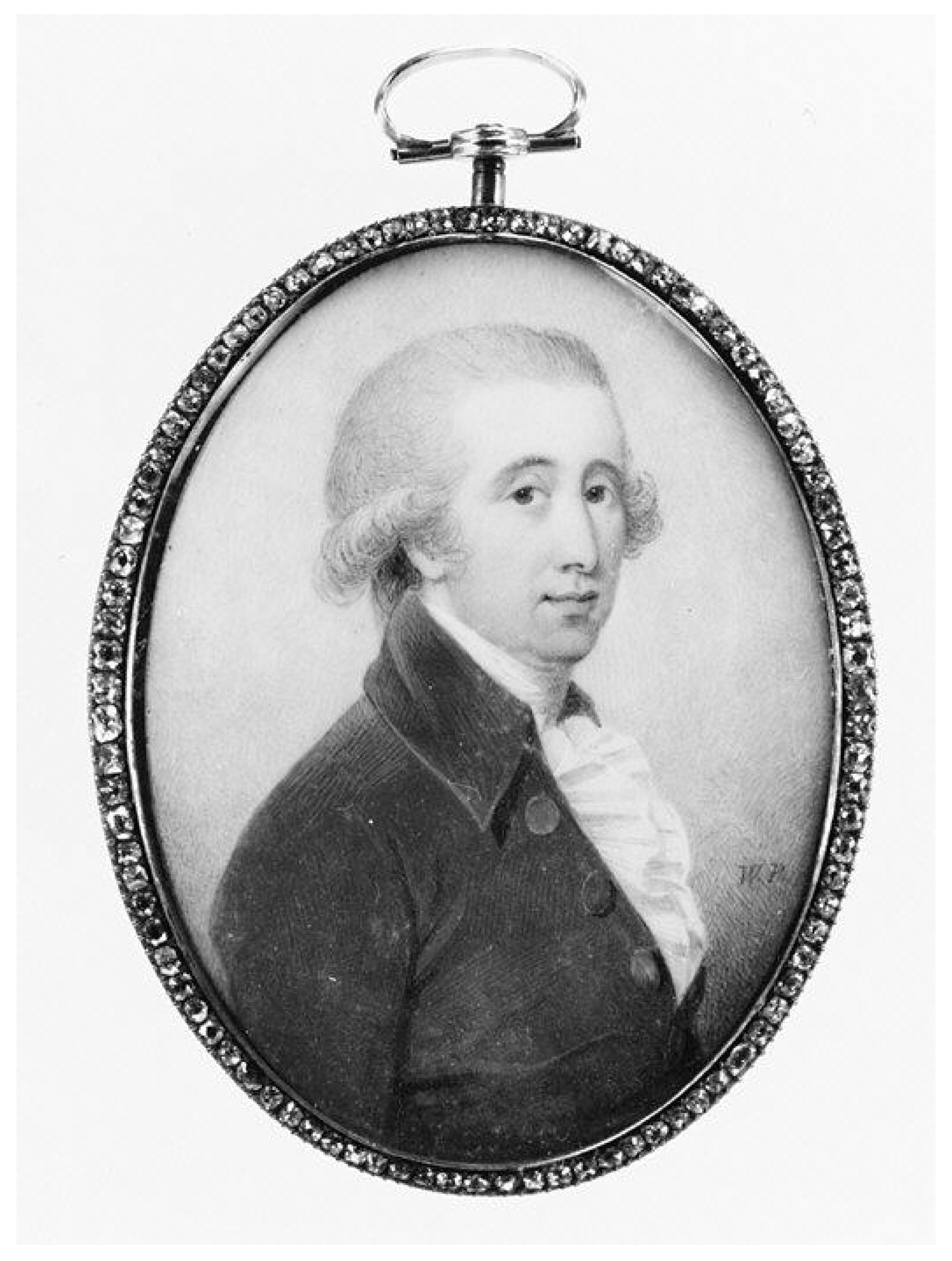
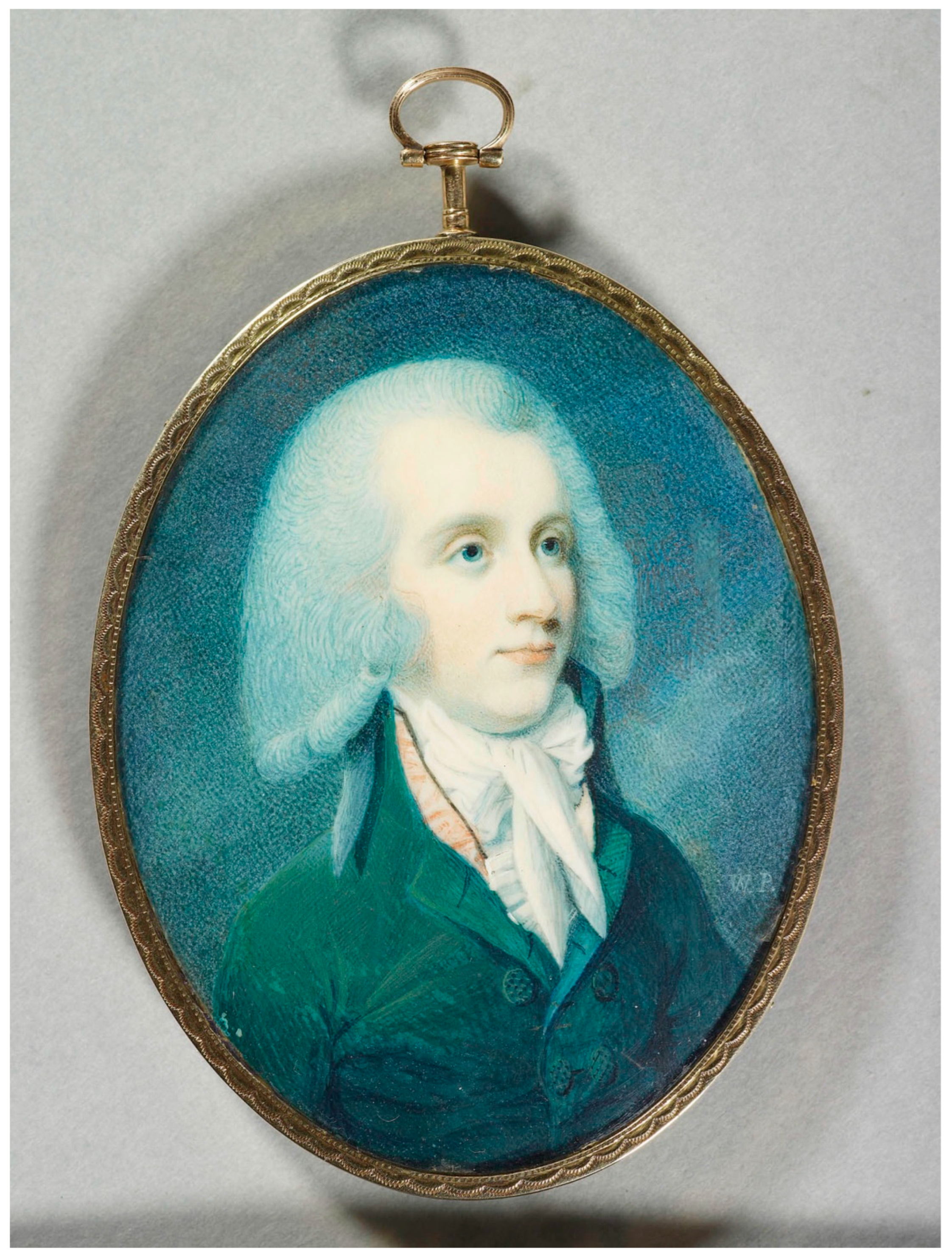
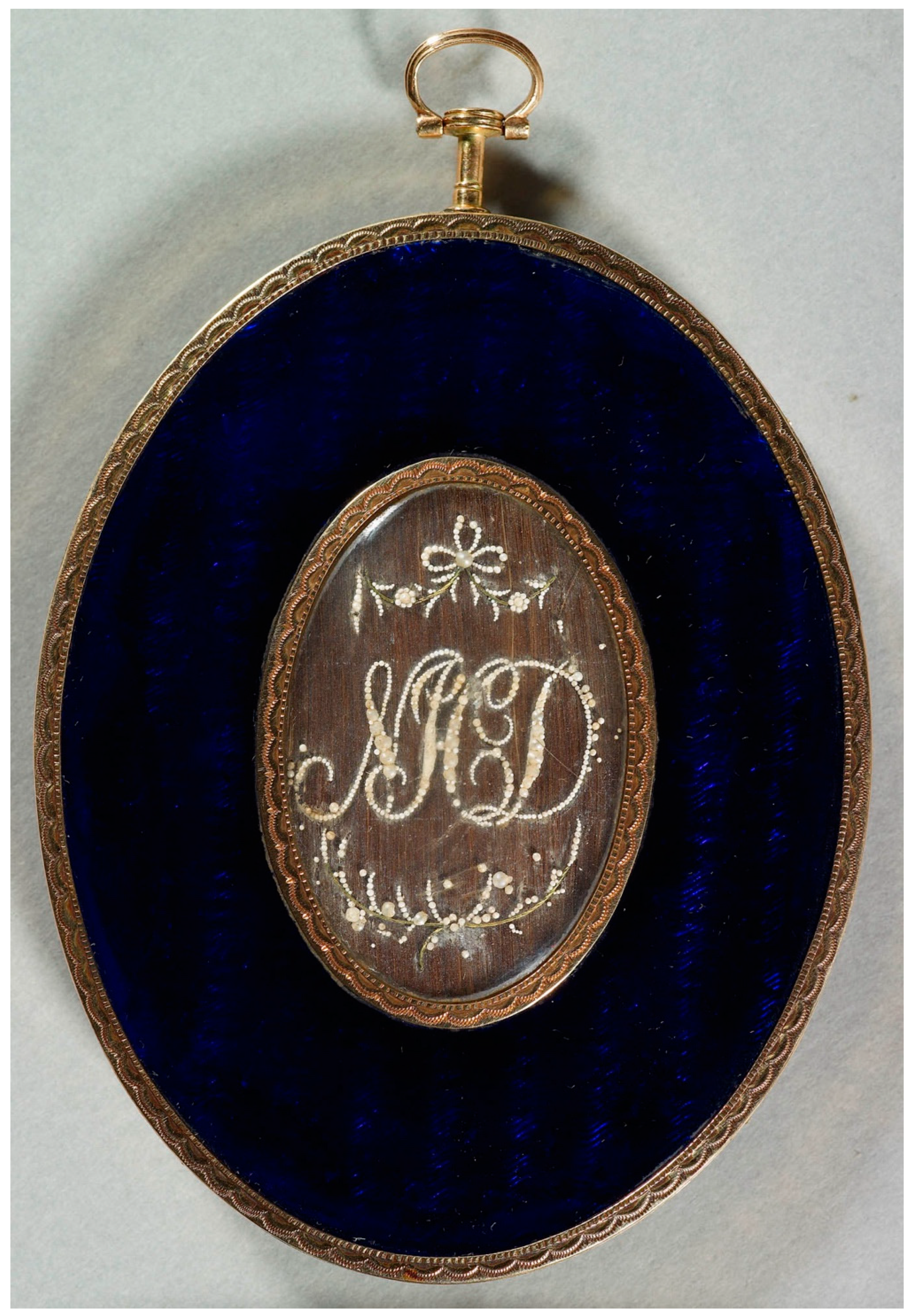
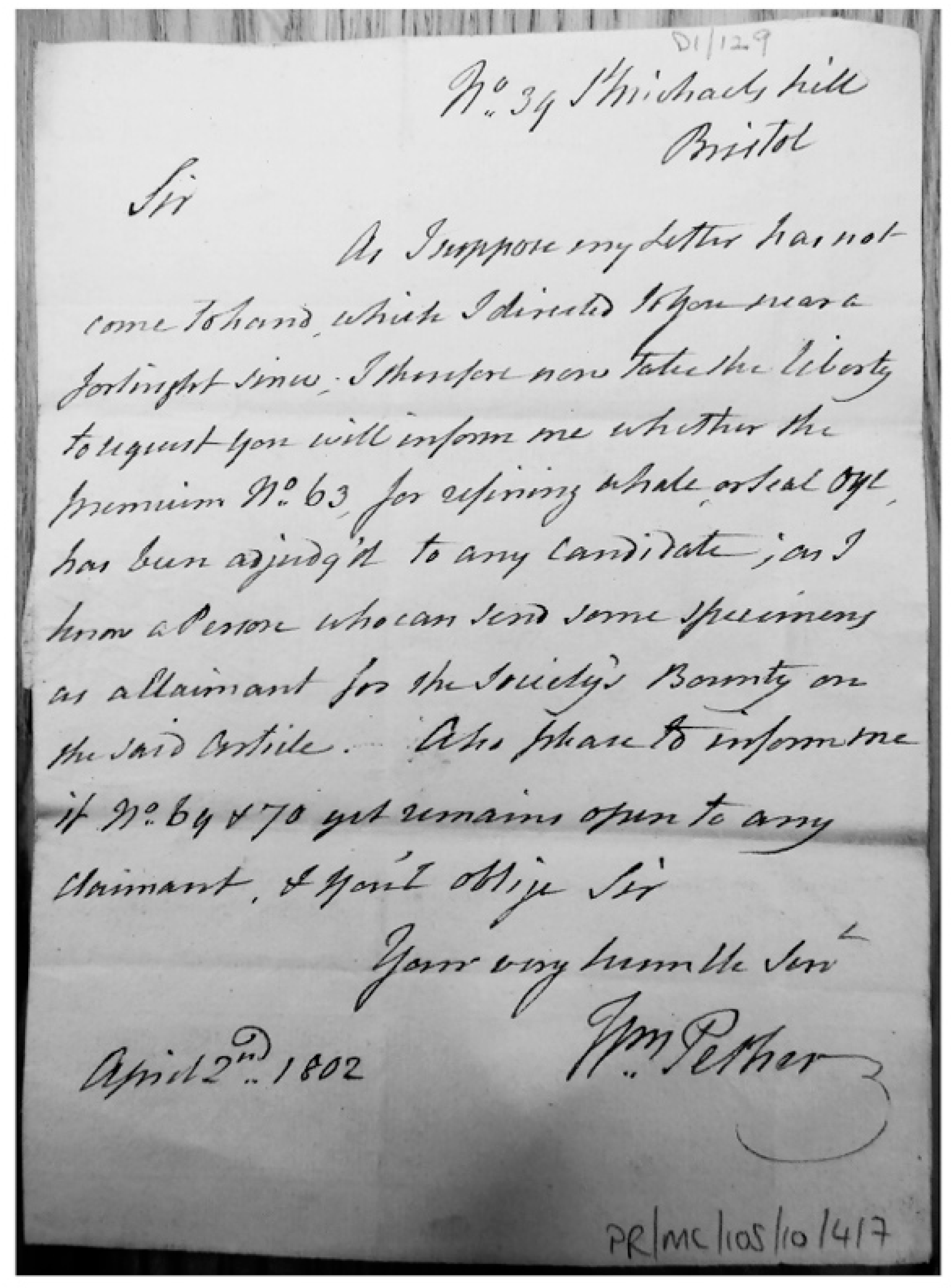
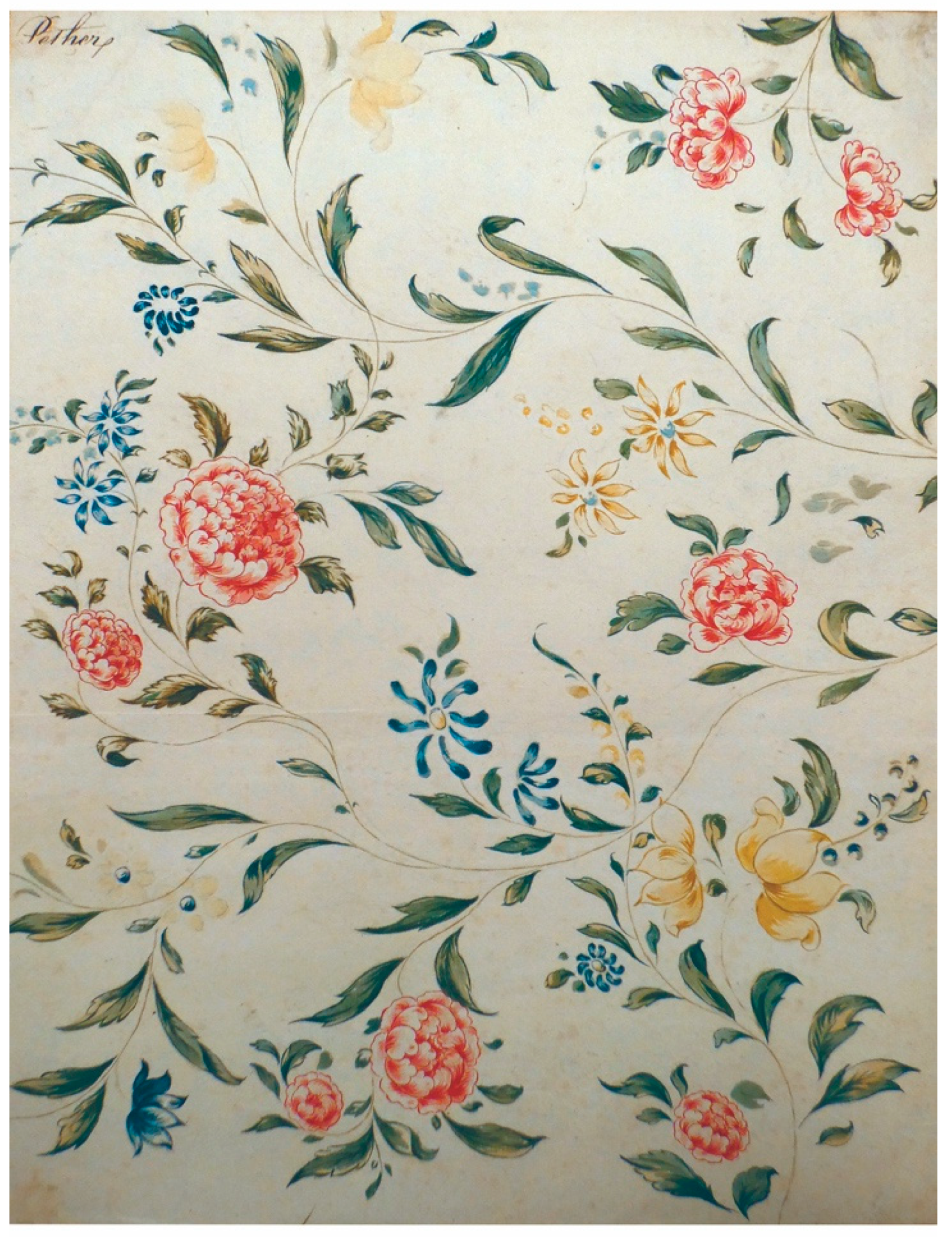
| The Free Society of Arts (FSA) | The Society of Artists of Great Britain (SAGB) | The Royal Academy of Arts (RA) |
|---|---|---|
| 1763: Portrait of a Gentleman; in miniature | 1764: A Lady; in miniature 1766: Two miniatures: Lady and Gentleman 1768: Portrait; in miniature 1769: A Miniature of a Gentleman ditto 1770: A Young Gentleman; a miniature 1771: Three Portraits; in miniature 1780: Portrait of a Lady; miniature | 1781: Portrait of a Lady Portrait of a Lady 1782: Frame with Portraits Portrait of a Lady 1783: Portrait of a Gentleman 1789: Portrait of a Young Lady of the Isle of Cyprus 1793: A Portrait 1794: Portrait of a Gentleman Portrait of a Gentleman |
Publisher’s Note: MDPI stays neutral with regard to jurisdictional claims in published maps and institutional affiliations. |
© 2022 by the author. Licensee MDPI, Basel, Switzerland. This article is an open access article distributed under the terms and conditions of the Creative Commons Attribution (CC BY) license (https://creativecommons.org/licenses/by/4.0/).
Share and Cite
Cora, D. Miniature Painting in Eighteenth-Century England: The Case of William Pether (1739–1821). Arts 2022, 11, 61. https://doi.org/10.3390/arts11030061
Cora D. Miniature Painting in Eighteenth-Century England: The Case of William Pether (1739–1821). Arts. 2022; 11(3):61. https://doi.org/10.3390/arts11030061
Chicago/Turabian StyleCora, Dominika. 2022. "Miniature Painting in Eighteenth-Century England: The Case of William Pether (1739–1821)" Arts 11, no. 3: 61. https://doi.org/10.3390/arts11030061
APA StyleCora, D. (2022). Miniature Painting in Eighteenth-Century England: The Case of William Pether (1739–1821). Arts, 11(3), 61. https://doi.org/10.3390/arts11030061






